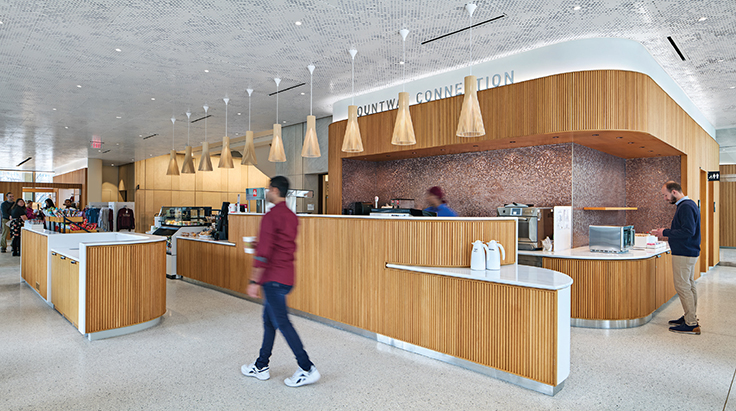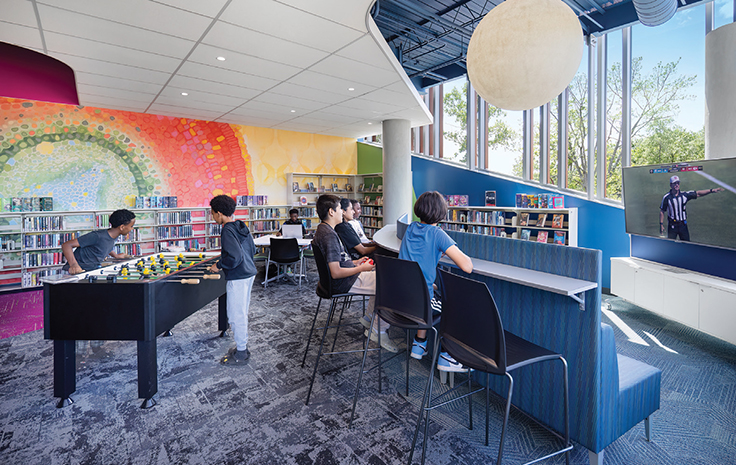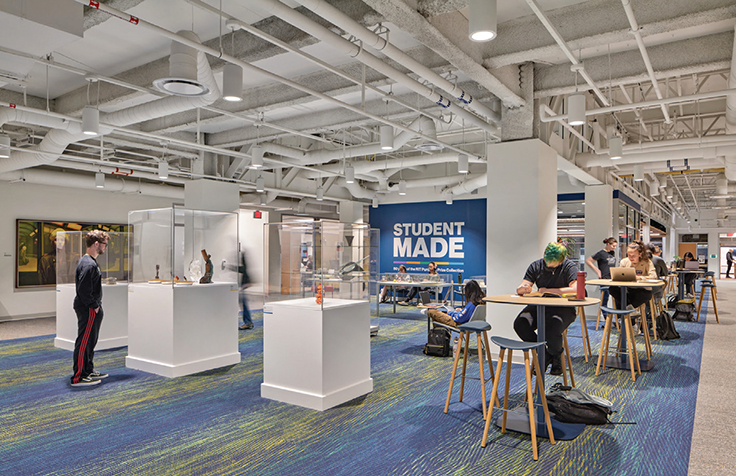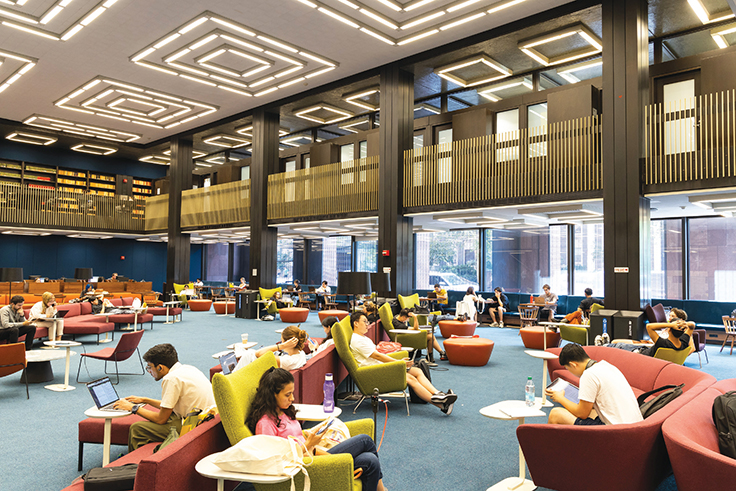Design Trend: Social Spaces | Year in Architecture 2024
Libraries continue to emerge from the pandemic, with spaces designed to promote social interaction along with quiet study—places that work for everyone.
DESIGN TREND: Social Spaces
Libraries continue to emerge from the pandemic, with spaces designed to promote social interaction along with quiet study—places that work for everyone. Accessibility is an essential factor; libraries include options that address the needs of diverse users. Bobst Library at New York University collaborated with students who identified as disabled or neurodivergent to enhance its central atrium with sensory-friendly details such as warm pendant lighting, sound-dampening surfaces, and calming color palettes.
Libraries continue to expand choices, not only in the variation of spaces but through furniture types and configurations, to support a continuum of activity. The renovation of Countway Library, Harvard Medical School, Cambridge, MA, encompasses the addition of a café and bookstore where lively conversations can take place. With the rise of collaborative projects and preference for study groups, libraries are building larger study rooms that include long tables. These can also serve as shared communal seating, so that individuals studying might engage in casual connections with others at the same table. The Wallace Library, Rochester Institute of Technology, NY, reimagined its design to align with a new role on campus as a “third space” for student life. Users can choose from lounge seats with low tables, couches, or even bistro high tables with stools to best fit their preferences for studying or socializing. These study areas are placed along circulation corridors to promote visibility for chance encounters.
Public libraries that serve broader audiences have developed areas of belonging for specific subgroups, such as teen spaces. In the Reynoldsburg Branch Library, Columbus Metropolitan Library, OH, thoughtful layouts encourage interaction. Combination counter and bench seating positioned toward a large screen sets up an opportunity for group viewing of films or sporting events. Shelves of young adult books and media along the perimeter walls become a destination point where informal conversations might happen. A foosball table is centrally placed with space for onlookers to gather around.
BACK TO YEAR IN ARCHITECTURE 2024 LANDING PAGE
 |
Countway Library, Harvard Medical School, Cambridge, MA; Shepley Bulfinch, architect; Robert Benson, photo. |
 |
Reynoldsburg Branch, Columbus Metropolitan Library, OH; Gund Partnership, Jonathan Barnes Architecture & Design, and Margaret Sullivan Studio, architects; © Brad Feinknopf/Feinknopf 2024, photo. |
 |
Wallace Library, Rochester Institute of Technology, NY; William Rawn Associates Architects and MRB Group, architects; Robert Benson, photo. |
 |
Bobst Library, New York University, NY; Tod Williams Billie Tsien Architects/Partners, architect; ©Hollenshead: courtesy of NYU Photo Bureau, photo. |
I am baffled by the apparent belief that any of these "tasks" are of sufficient merit to overcome the massive environmental, legal, ethical, educational and quality drawbacks of LLM "AI". Anyone who thinks that students would draw benefit from having a machine spit out a mediocre and potentially error-raddled summary or outline instead of creating their own; or that a workplace would be improved by context-free workflow; or thinks that they would save time or effort by letting an algorithm concoct their "low-stakes" presentation or artwork which will need extensive double-checking and correcting for hallucinations, is probably already cool with the idea that they are stealing words and images created by real live humans without compensation, and melting the planet we all have to share to do it.
But sure, let's have a flagship association for librarians promote and cheerlead this destructive and pointless technology. We're so desperate to appear hip and trendy that we're happy to give up the expertise and judgment that makes our profession valuable.
while I do think your concerns are valid, I believe there is also potential for AI to enhance library services when implemented thoughtfully and ethically. The key is to strike a balance, leveraging AI's strengths while maintaining the core values and expertise that define the library profession.
Add Comment :-
RELATED
ALREADY A SUBSCRIBER? LOG IN
We are currently offering this content for free. Sign up now to activate your personal profile, where you can save articles for future viewing









